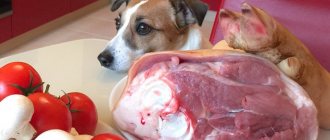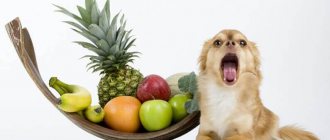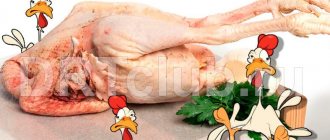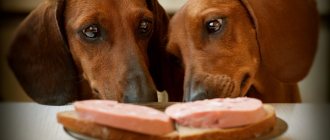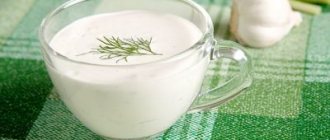Fish in a dog's diet
Fish is recommended for feeding raw or boiled 2-3 times a week instead of meat and offal in the same quantity. The daily amount of food for puppies is 6-8% of weight, for adult dogs - 4%. 50-70% should come from animal products.
Fish is good for dogs, but within reasonable limits
Fish is very healthy. It contains many vitamins and microelements. Including it in the diet has a beneficial effect on the condition of joints, skin and coat. Excessive consumption can negatively affect metabolism and cause urolithiasis and other problems.
The need to eat meat
The digestive system of carnivorous mammals, which includes the domestic dog, has its own characteristics. Attentive owners probably know that in the process of eating food, dogs practically do not chew it, they easily bite off and swallow large pieces. Dog saliva contains almost no necessary enzymes. The digestion process begins in the stomach. In dogs it is large, with a very high level of acidity. This promotes better absorption of meat foods.
Meat should be the main component in a pet's menu. From it the dog receives a maximum of useful vitamins, microelements, proteins, and amino acids. These substances:
- supply the body with energy;
- strengthen bones and muscles;
- improve the condition of the coat and skin;
- have a beneficial effect on the hematopoietic mechanism;
- strengthen the immune system.
What fish should not be given to a dog: myths and facts
The enzyme thiaminase in fish breaks down vitamin B1.
Some types of fish actually contain this enzyme: sea bream, anchovy, sprat, sorog, sprat, burbot, perch, smelt, crucian carp, sardine, sardinella, herring, capelin, ide, herring, smelt, minnow, sea bream, pike, carp. Feeding them raw on a regular basis can lead to hypovitaminosis B1. Most thiaminase is found in the head and viscera. After heat treatment for 20 minutes, it is completely destroyed.
The substance trimethylamine oxide causes iron deficiency anemia.
A dangerous compound is found in pollock, capelin, haddock, silver hake, pollock, hake, cod, pout, blue whiting, and skinny herring. Feeding these types of fish to puppies in very large quantities can cause developmental delays, and in adult bitches - infertility. If you give these types of fish to your dog occasionally, there will be no harm.
Fish should not be eaten raw due to parasites.
Parasites that can infect humans and dogs can be present in any freshwater fish with the exception of sturgeon (sturgeon, beluga, sterlet, stellate sturgeon, thorn) and many sea fish (cod, flounder, trout, mackerel, capelin, others). Fish is disinfected by cooking (at least 20 minutes) or freezing (5 days at -20°C).
Fish causes vomiting and upset.
Fatty fish can really have a negative impact on digestion. Individual intolerance also occurs.
Fish contains histamine, which can cause poisoning.
Histamine is a biogenic amine that is formed in fish and fish products when storage conditions are violated. It is also dangerous for humans. The histamine content is standardized and is the most important indicator of freshness. Risk factors are
smoked, salted products, preserves and canned fish rich in histidine: horse mackerel, mackerel, saury, tuna, mackerel, sprat, herring, salmon. An increase in histamine can also be provoked by repeated freezing.
Poisonous fish.
You won’t find them on store shelves, but amateur fishermen who delight their favorites with their catch need to know about them: Balkhash marinka, khramulya, dogfish, pufferfish, and others.
Fish should not be given because of the bones.
It all depends on the size of the dog and the fish. For example, Yorkies and Chihuahuas can safely feed small anchovies whole. Larger fish can be cut up, choosing fillets, boiled or ground into minced meat. The bones of a lenok weighing 3-4 kg can harm even a large Asian, which has no problem swallowing a bull calf whole.
Clinical treatment of food poisoning
In general, it is impossible to describe a specific clinical treatment, since everything will depend on the individual case. For example, the treatment of poisoning caused by ordinary spoiled food is completely different from the treatment of poisoning by rat baits.
But still, general points can be highlighted:
- The stomach is washed out except in cases where it is undesirable or simply too late.
- If, based on the results of the tests, or based on the characteristics of the clinical picture, it is possible to find out what exactly the dog was poisoned with, an antidote is prescribed (if available). Alas, it is not always possible to do this, and even less often on time.
- In some cases (but not always) enemas are indicated. By the way, they are more often used after the “acute” stage, introducing enveloping compounds into the dog’s body. They help accelerate the healing of mucous membranes.
- Almost any poisoning (not just food poisoning) requires hepatoprotectors. They help the liver recover as quickly as possible and help eliminate the remains of associated toxins.
- In especially severe cases, complete or partial blood transfusion is indicated. Much more often (due to much greater availability) they resort to plasma transfusions.
Can dogs eat ear? Pros and cons
For many owners, it becomes a discovery that it is undesirable to give broth to dogs. The thing is that it promotes the production of gastric juice. On a regular basis, this can lead to the development of gastritis and ulcers. Rich broth negatively affects the pancreas and liver. The first decoction may contain toxins and undigested fats. Broth cooked for yourself is also dangerous because it often contains salt and spices. On the other hand, ear contains glucosamine, natural gelatin, and several other substances that are good for joints and promote the absorption of carbohydrates.
From the above, the conclusion follows: the first water when cooking the broth should be drained, it is better to cook the fish soup using low-fat varieties of fish and not give it to the dog regularly. If you pamper your pet occasionally there will be nothing wrong.
No matter how healthy the fish is, you should always take into account the food preferences of your pet and the peculiarities of its digestion.
Natural feeding
At the request of friends and acquaintances, I am publishing my natural feeding scheme.
But first I want to say this. I am not a canine nutritionist. And I’m not waving a banner that says “This is the only way to feed dogs!” I am a doctor and I have a good basic understanding of physiology, incl. physiology of digestion. And I have 2 dogs who have been eating this way for many years, without getting sick and maintaining excellent physical shape (those who wish can see this every week at the races). An important addition - my dogs do not have any food allergies and do not require any therapeutic diet! Now I’ll just describe my feeding regimen.
Recommended quantity
How much meat do you need per day? It depends on the breed of the dog, its age, gender, weight, lifestyle, and health status.
The dog should eat such a volume that the main amount of animal proteins in the diet ranges from 40% to 70%.
- For a sedentary animal that lives in an apartment, 10-20 grams per day per 1 kg of body weight will be enough.
- A young active pet needs more - up to 30 grams per 1 kg of weight.
- The puppy's norm should be increased. For the proper development of a growing body, a complete diet is needed. Depending on the breed and weight, the puppy can be fed a maximum of 1 to 2.5 kg of meat every day.
It is better to divide the daily recommended volume into several feedings.
For a person weakened after an illness or an elderly person, the daily norm should also be higher. If a dog has kidney failure, the amount of protein is strictly dosed. When fighting excess weight in a pet, increase the amount of food rich in proteins, while reducing the content of fats and carbohydrates.
Raw or cooked
Although raw meat is a natural food for dogs, the answer to this question is controversial. Both raw and cooked foods have advantages and disadvantages. When making a decision, the owner must clearly understand the benefits and possible harms of the chosen feeding method.
Raw meat
| pros | Minuses |
| High nutritional value Rich in essential amino acids Correct formation of the animal’s skeleton and muscle tissue Prevention of anemia - increasing the level of hemoglobin in the blood Improvement of the immune system and overall endurance of the body Prevention of diseases of the animal’s teeth and jaws by chewing coarse meat fibers | Danger of infection with helminths and infectious diseases |
Cooked meat
| pros | Minuses |
| Safe against parasites and some infectious diseases | After heat treatment, meat loses some of its beneficial properties and decreases in volume. Boiled meat reduces satiety and nutritional value. |
The high concentration of hydrochloric acid in a dog's stomach allows it to disinfect stale food contaminated with pathogenic microorganisms. Despite this, you should only feed your dog raw meat if you have full confidence in its safety and high quality.
Only meat from farm animals that is purchased in a store can be considered uncontaminated. It is subject to mandatory sanitary and veterinary control.
Raw meat from wild animals, such as small rodents, is strictly not recommended for your dog. Hunting dog breeds are at risk when walking through the forest with their owner.
To protect raw meat of questionable quality, you can place it in the freezer for several days. Parasite eggs die from a sharp drop in temperature.
Important! When preparing a meat dish for a dog, you should not add salt or other spicy spices. If you are thinking about whether you can treat your pet to a tasty piece of smoked meat, it is better to refuse it. Food additives in such meat have a negative effect on the condition of the dog’s liver.
The broth left over after cooking meat should not be fed to the dog - it is too concentrated. You can use it to cook cereal porridge or vegetables.
Foods that are not recommended for animals to consume
Bread and flour products
Many owners sometimes allow their pets to eat buns or cookies. Yeast, which is present in almost all flour products, very often causes flatulence. Also, dogs fed buns may have sore eyes and bad teeth. If you want to pamper your pet, then you can give some dried crackers as a treat.
You may also be interested in reading about whether you can give your dog pasta.
Legumes
All vegetables of the legume family are very difficult to digest and digest by the dog’s body. In addition, they cause gases in the intestines. These vegetables include peas, lentils and beans.
Potato
Potatoes are harmful to dogs in any form. Raw potatoes contain the toxic substance solanine, the consumption of which in large quantities can lead to the death of your pet. Boiled potatoes contain a lot of carbohydrates, which are completely useless for the animal.
Celery
Celery is a product rich in vitamins. But its consistency is very hard and fibrous.
We all know that when eating food, the dog hardly chews it, but swallows it in large pieces. And it is very difficult for unchewed pieces of celery to pass through the esophagus. Therefore, if you want to enrich your pet’s food with nutrients, you can grind the celery in a meat grinder and simply add the tail to the food.
Now let's talk about the category of products that are safe for animals in moderation, but still should not be carried away.

